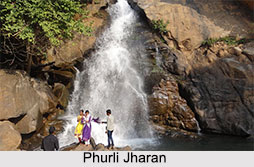 Tourism in Bhawnipatna deals with the dense forests, Hindu temples formed in Deula Structure and many archaeological places of importance. There are several places of archaeological, historical and mythological significance in Bhawnipatna that attract many tourists from all over the country.
Tourism in Bhawnipatna deals with the dense forests, Hindu temples formed in Deula Structure and many archaeological places of importance. There are several places of archaeological, historical and mythological significance in Bhawnipatna that attract many tourists from all over the country.
Phurli Jharan
Phurli Jharan is situated at a short distance of just 15 km from Bhawanipatna. It is one of the worth visiting among the waterfalls of Odisha. The cascading waterfall of Phurli Jharan comes down with full force from a height of 16 meters. The water fall is located at a picturesque landscape that offers the local citizens and the tourists to enjoy themselves in the lap of nature. It also serves as an ideal picnic spot in late winters and autumns.
Karlapat Wildlife Sanctuary
Karlapat Wildlife Sanctuary was established on 6th January, 1969 with many animals and birds. It houses many endangered species of animals including Royal Bengal Tiger, sambars, leopard, guars and chitals. The hilly terrain, draped in tropical deciduous forests, gives way to the encroaching plateau in some places and makes for an ideal place for animal and bird watching.
Thamul Rampur Forest Reserve
Thamul Rampur Forest Reserve is the best option for the tribal tourism in India. Even the tribal tours to Thamul Rampur Forest Reserve near the Karlapat Wildlife Sanctuary, serves as a tourist spot. Haladigundi Valley in Ambapani Hills is another popular place to catch wildlife in their natural habitats.
Belkhandi
Belkhandi is a beautiful plain land with the confluence of rivers. It is located on the confluence of the rivers Tel and Utei. It is a place of archaeological importance.
Ambapani
Ambapani is located 77 kilometres from Bhawanipatna and 45 kilometres from Nowrangpur. Ambapani is famous for the deity of Budharaja that is placed in a small temple at the foot of a hill. The picturesque Ambapani hills present a panoramic view of nature. A frolicking valley called Haladigundi in this range of hills presents some peculiar features due to the reflected rays of the sun. The whole area abounds in Spotted Deer, Sambar and Black Panthers which can be seen at the Behera reservoir.
Budhikomna
Budhikomna houses the unique brick temple of Pataleswar. It is 40 km from Khariar.
Yogimath
Yogimath is located 9 km east of Khariar. It is famous for the cave paintings of Neolithic age in Odisha.
Related Articles
Cities of Orissa
Bhawanipatna
Temples of Odisha
Odisha, Indian state
Nature Tourism in Odisha
Tourism in Odisha
Puri
Orissa Cuisine, Indian Food
Tribes of Odisha



















